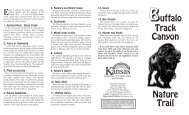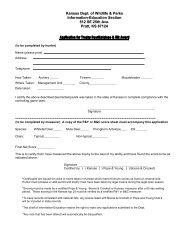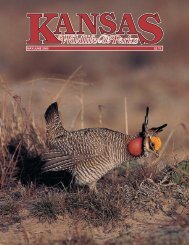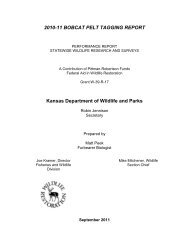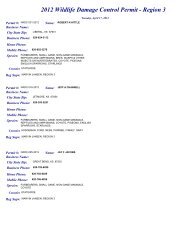2009-10 Furbearer Harvest Survey Report - Kansas Department of ...
2009-10 Furbearer Harvest Survey Report - Kansas Department of ...
2009-10 Furbearer Harvest Survey Report - Kansas Department of ...
Create successful ePaper yourself
Turn your PDF publications into a flip-book with our unique Google optimized e-Paper software.
mange were more successful at establishing territories and reproducing than those with mange,<br />
resulting in a rapid shift in the population towards mange-resistant coyotes. In this study, the<br />
presence <strong>of</strong> mange even at high prevalence did not lead to a population decline in coyotes, but<br />
coyotes also did not die as a result <strong>of</strong> mange from cold weather. This cycle <strong>of</strong> fairly rapid<br />
increase followed by a several year period <strong>of</strong> high prevalence, then decline and sporadic<br />
persistence seems consistent with mange in eastern <strong>Kansas</strong>, and should probably be expected in<br />
parts <strong>of</strong> western <strong>Kansas</strong> that have experienced fairly recent mange outbreaks as well.<br />
Locating less common species – The <strong>Kansas</strong> Mammal Atlas, maintained by Fort Hays State<br />
University, is a resource that can be used to identify locations, at least to the county, where<br />
<strong>Kansas</strong> mammals, including less common furbearers such as weasels and gray foxes, have been<br />
documented. Locations <strong>of</strong> museum specimens and other documented cases are provided. The<br />
Atlas is located on the web at http://webcat.fhsu.edu/ksfauna/mammals/index.asp<br />
Extending WIHA leases for furbearer/coyote hunting – Fall WIHA properties are open to<br />
furbearer and coyote hunting through January 31. If we assume it would cost the <strong>Department</strong> an<br />
extra 20 cents an acre to lease 1 million acres <strong>of</strong> WIHA for an extra two weeks, the lease cost<br />
alone would be $200,000 a year excluding other expenses such as changing signs or<br />
renegotiating contracts. The total value from furharvester license sales in <strong>2009</strong> was $123,000,<br />
plus it is questionable how much demand there really is for additional late season hunting access<br />
to furbearers or coyotes. Extending WIHA for predator hunting doesn’t seem logical at this<br />
time.<br />
“The questions are terrible.” Many traps and sets target many animals at the same time –<br />
We realize trappers may set for multiple species, and we tried to account for this in the<br />
instructions (“Count any day you had sets out that were likely to catch that species. For<br />
example, if you caught opossums in your raccoon sets, record your raccoon trapping days for<br />
opossum also.”). We ask how many days one trapped and the number <strong>of</strong> traps set per day for<br />
each species in hopes <strong>of</strong> obtaining an ESTIMATE <strong>of</strong> harvest effort. When combined with<br />
harvest estimates, this information is used to provide an index to furbearer abundance called<br />
“catch per unit effort.” For example, if the bobcat catch changes from 1 cat per 20 trap nights to<br />
1 cat per 25 trap nights over time, we can assume the population has declined. Nocturnal and<br />
secretive furbearers are hard to monitor, and this is an important measure to us. <strong>Harvest</strong> alone is<br />
dependent upon pelt values, weather, and other factors, and cannot be used in this manner. By<br />
providing estimates <strong>of</strong> your trapping effort, you not only allow us to estimate harvest, but you’re<br />
also telling us more about furbearer populations than you might have imagined. This translates<br />
into better-managed furbearer populations and sometimes even more opportunity for you.



